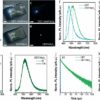In Nature Physics, the LSU Quantum Photonics Group offers fresh insights into the fundamental traits of surface plasmons, challenging the existing understanding. Based on experimental and theoretical investigations conducted in Associate Professor Omar Magaña-Loaiza’s laboratory, these novel findings mark a significant advancement in quantum plasmonics, possibly the most noteworthy in the past decade.
While prior research in the field has predominantly focused on the collective behaviors of plasmonic systems, the LSU group adopted a distinct approach. By viewing plasmonic waves as a puzzle, they were able to isolate multiparticle subsystems, or break down the puzzle into pieces. This allowed the team to see how different pieces work together and revealed a different picture, or in this case, new behaviors for surface plasmons.
Plasmons are waves that move along the surface of metals when light is coupled to charge oscillations. Much like tossing pebbles into water generates ripples, plasmons are “ripples” traveling along metal surfaces. These minute waves operate on a nanometer scale, rendering them crucial in fields such as nanotechnology and optics.
“What we found is that if we look at the quantum subsystems of plasmonic waves, we can see inverse patterns, sharper patterns, and opposite interference, which is completely opposite to the classical behavior,” explained Riley Dawkins, a graduate student and co-first author of the study, who led the theoretical investigation.
Using light aimed at a gold nanostructure and observing the behavior of scattered light, the LSU quantum group observed that surface plasmons can exhibit characteristics of both bosons and fermions, which are fundamental particles in quantum physics. This means that quantum subsystems can exhibit non-classical behaviors, such as moving in different directions, depending on specific conditions.
“Imagine you are riding a bike. You would believe that most of your atoms are moving in the same direction as the bike. And that is true for most of them. But in fact, there are some atoms moving in the opposite direction,” explained Magaña-Loaiza.
“One of the consequences of these results is that by understanding these very fundamental properties of plasmonic waves, and most importantly, this new behavior, one can develop more sensitive and robust quantum technologies.”
In 2007, the use of plasmonic waves for anthrax detection sparked research into employing quantum principles for improved sensor technology.
Presently, researchers are striving to integrate these principles into plasmonic systems to create sensors with heightened sensitivity and precision. This advancement holds significant promise across diverse fields, including medical diagnostics, drug development simulations, environmental monitoring, and quantum information science.
The study is poised to make a significant impact on the field of quantum plasmonics, as researchers worldwide will leverage the findings for quantum simulations. Chenglong You, Assistant Research Professor and corresponding author, said, “Our findings not only unveil this interesting new behavior in quantum systems, but it is also the quantum plasmonic system with the largest-ever number of particles, and that alone elevates quantum physics to another level.”
Graduate student and co-first author Mingyuan Hong led the experimental phase of the study. Despite the complexities of quantum plasmonics systems, Hong noted that his primary challenges during the experiments were external disturbances.
“The vibrations from various sources, such as road construction, posed a significant challenge due to the extreme sensitivity of the plasmic sample. Nevertheless, we eventually succeeded in extracting quantum properties from plasmonic waves, a breakthrough that enhances sensitive quantum technologies. This achievement could open up new possibilities for future quantum simulations.”
Titled “Nonclassical Near-Field Dynamics of Surface Plasmons,” the research was conducted entirely at LSU. “All the authors of this study are affiliated with LSU Physics & Astronomy. We even have a co-author who was a high school student at the time, which I’m very proud of,” said Magaña-Loaiza. This new research is prefaced by previous LSU work.
More information:
Mingyuan Hong et al, Nonclassical near-field dynamics of surface plasmons, Nature Physics (2024). DOI: 10.1038/s41567-024-02426-y
Provided by
Louisiana State University
Citation:
Multiparticle nanostructures for building better quantum technologies (2024, March 4)



